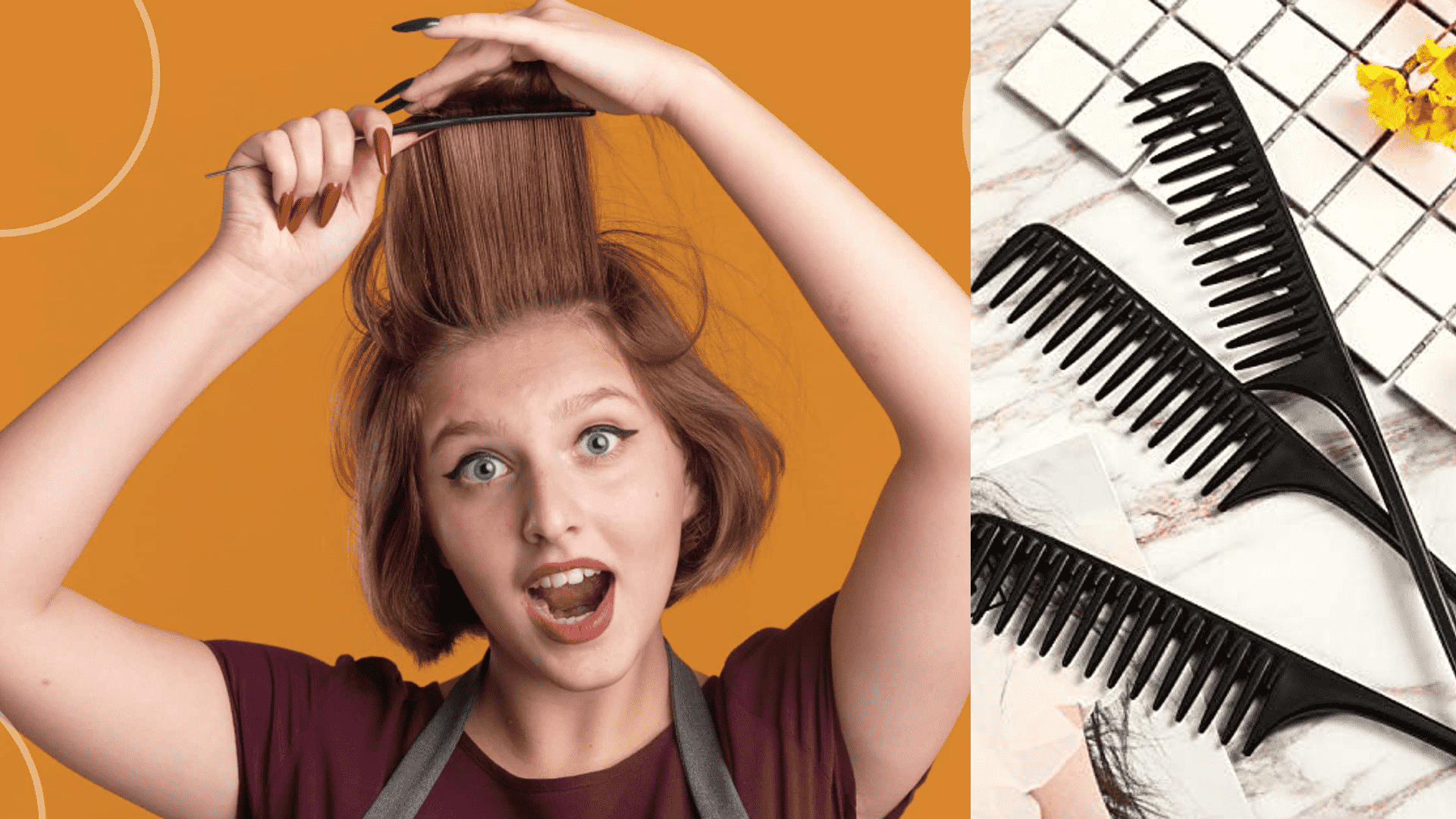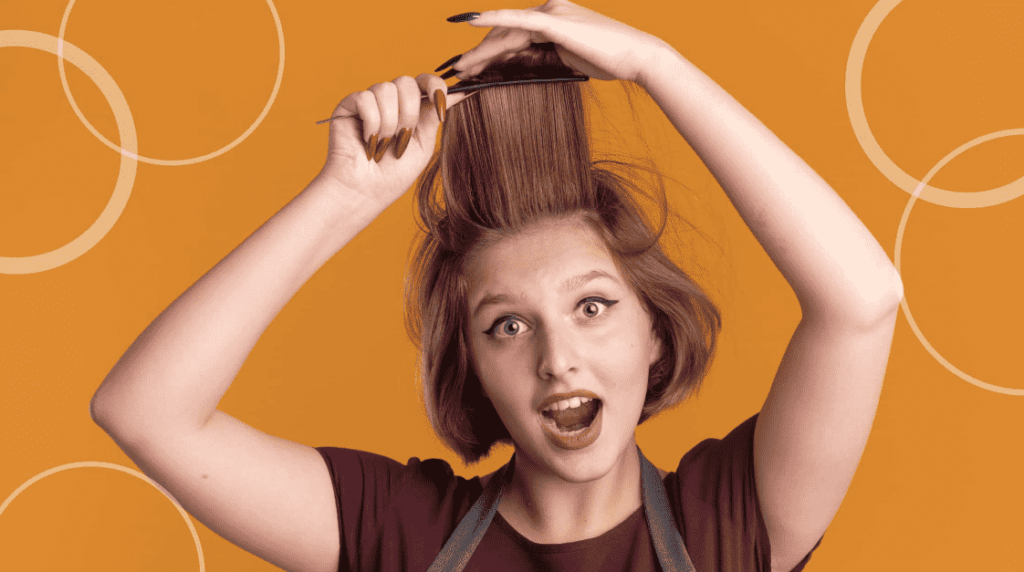Fashion
The Ultimate Guide to the Rat Tail Comb: And 5 Uses

Rat tail comb is one of the most versatile tools in hairstyling, yet it remains one of the least discussed. Whether you’re a professional hairstylist or someone who loves DIY hair care, this slim yet powerful tool can elevate your hairstyling game.
In this article, we’ll break down everything you need to know about the rat tail comb, its history, uses, and how it can benefit your daily hair routine. We’ll also answer five frequently asked questions at the end to clear up any lingering doubts. Let’s dive into the magic of the rat tail comb!
What is a Rat Tail Comb?
A tail comb is a comb that features a long, thin, and pointed handle that resembles a rat’s tail, hence its name. The comb usually has closely spaced teeth, which makes it ideal for detailed hair work like parting, teasing, and sectioning.

For more beauty tips, Visit BusinessRadar
Key Characteristics:
- Long, pointed handle: Perfect for sectioning and parting hair.
- Fine teeth: Great for smoothing and detangling small sections of hair.
- Lightweight and portable: Easily fits into a stylist’s toolkit.
The tail comb is a must-have for anyone looking to create precise and professional hairstyles, from sleek updos to voluminous curls.
History of the Rat Tail Comb
Although the rat tail comb has seen a resurgence in recent years, it’s been used in hairstyling for centuries. In ancient Egypt, hairstylists used primitive versions of the tail comb to section hair for elaborate styles. The comb became more standardized in the mid-20th century, gaining popularity in both salons and homes.
Its compact design made it an instant hit with hairstylists, especially during the 1960s when voluminous hairstyles like the beehive required teasing and backcombing. Today, it remains a go-to tool for both professionals and amateurs alike.
Top Uses of the Rat Tail Comb
1. Sectioning Hair
One of the primary functions of a tail comb is to create neat and precise sections in the hair. The pointed handle (or “tail”) can easily slice through the hair, allowing you to work on one section at a time without disrupting the rest.
How to Use for Sectioning:
- Hold the rat tail comb at an angle and use the pointed tip to divide the hair into clean sections.
- This is especially useful for hairstyles like braids, cornrows, and any style requiring even partings.
Pro Tip: Using a rat tail comb for sectioning makes styling easier and prevents hair from becoming tangled.
2. Creating Perfect Partings
The fine teeth of a rat tail comb ensure that you can create clean, straight partings in the hair. Whether you’re going for a deep side part or a classic middle part, the rat tail comb helps in achieving professional-level precision.
How to Use for Parting:
- Place the pointed end of the comb at the crown of the head and gently drag it through the hair to create the part.
- Once the part is made, use the comb’s teeth to smooth the hair on either side.
Pro Tip: For extra neatness, apply a light mist of hairspray before creating the part to hold the hair in place.
3. Teasing Hair for Volume
If you want to add volume to your hair, teasing (or backcombing) is the way to go. The closely spaced teeth of the rat tail comb are perfect for this technique.
How to Tease:
- Take a small section of hair and hold it straight up.
- Use the comb to gently comb the hair downward from the mid-shaft toward the roots, creating a cushion of volume.
- Smooth the top layer of hair over the teased section for a polished look.
Pro Tip: Be gentle to avoid damaging your hair. Always use the teasing technique on dry hair.
4. Smoothing and Polishing
While the rat tail comb is excellent for teasing and parting, it’s also great for smoothing out sections of hair. The fine teeth can help you achieve sleek, polished styles without causing frizz or flyaways.
How to Use for Smoothing:
- After styling your hair, run the fine teeth of the rat tail comb over the surface to smooth any unruly strands.
- This is especially useful when styling updos, buns, or ponytails.
Pro Tip: Apply a small amount of hair serum before smoothing to achieve a shiny, frizz-free finish.
5. Applying Hair Products
Believe it or not, the rat tail comb is also handy for evenly distributing hair products like dye, mousse, or heat-protectant sprays. The fine teeth ensure that the product reaches every strand without clumping.
How to Apply Products:
- Dip the comb in the product and run it through your hair section by section.
- This method is particularly useful when applying hair dye or toner at home, ensuring full coverage.
Pro Tip: Use the comb to work the product from root to tip for a consistent application.
Materials and Types of Rat Tail Combs
Rat tail combs come in a variety of materials, each with its unique benefits:
Plastic Combs
- Lightweight and affordable.
- Available in various colors.
- Best for everyday use.
Metal Combs
- Durable and ideal for professional use.
- The metal handle provides more precision for sectioning.
- Best for intricate styles and tight partings.
Carbon Fiber Combs
- Heat-resistant and durable.
- Perfect for use with hot styling tools like curling irons and straighteners.
- Highly durable and won’t break easily.
Choosing the right material depends on your specific needs, but plastic combs are generally best for casual use, while carbon fiber or metal combs are preferred by professionals.
(FAQs)
1. Is a rat tail comb damaging to hair?
A rat tail comb is not inherently damaging to hair, but as with any styling tool, it can cause breakage if used improperly. When teasing hair, make sure to be gentle and avoid rough backcombing, which can weaken the hair shaft.
2. Can a rat tail comb be used on curly hair?
Yes, a rat tail comb can be used on curly hair, particularly for sectioning and parting. However, for detangling curly hair, it’s better to use a wide-tooth comb to avoid frizz and breakage.
3. Is a rat tail comb heat-resistant?
Plastic rat tail combs are generally not heat-resistant, but carbon fiber and metal combs are designed to withstand heat and can be used with hot styling tools like straighteners or curling irons.
4. What is the best way to clean a rat tail comb?
To clean a rat tail comb, soak it in warm, soapy water for a few minutes. Then, use a toothbrush to scrub between the teeth and along the handle. Rinse thoroughly and allow it to air dry.
5. Can a rat tail comb be used for hair coloring?
Yes, the rat tail comb is an excellent tool for applying and distributing hair color evenly. The fine teeth help to spread the dye through the hair, while the pointed handle is useful for sectioning during the coloring process.
Conclusion
The rat tail comb may seem like a small, unassuming tool, but its versatility makes it an essential part of any hairstyling kit. From sectioning and parting to teasing and smoothing, this comb does it all. Whether you’re a professional stylist or someone looking to improve their home hair care routine, the rat tail comb is a tool worth investing in.
Remember to choose the right material based on your needs, and always handle your hair gently to prevent damage. With the rat tail comb in your arsenal, you’ll be able to create sleek, professional styles effortlessly.
Fashion
Accessorising Kids Costumes: Top Tips for Fabulous Finishes

While the costume plays a significant role in parties and events, accessories can elevate the overall look and make it truly memorable. Adding thoughtful details to kids’ fancy dress enhances their charm and allows creative personalisation. Smiffys offers a wide range of creative accessories to help you add the perfect finishing touches to any kids’ costume, making dress-up time even more magical. Let’s explore how to accessorise children’s costumes perfectly for that extra wow factor.
Choosing Accessories That Match the Theme
Accessories should always complement the costume’s theme to create a cohesive look. For instance, a pirate costume could be paired with an eye patch, a toy sword, or even a tiny treasure chest. Sticking to the theme makes the costume feel complete and well-thought-out, leaving a lasting impression.
Consider the practicality of accessories when selecting them. A heavy prop or an intricate piece may look impressive but can make it hard for children to move freely. Choose lightweight and durable items that are easy for kids to carry and wear without discomfort.
Prioritising Comfort and Safety
While accessories can be exciting, it’s crucial to consider comfort and safety. Ensure that any props or add-ons don’t have sharp edges or small parts that could pose a choking hazard. Items like headbands or hats should fit snugly without irritating or pressing the child’s head.
Safety is equally important when choosing materials. Opt for non-toxic face paints, child-safe jewellery, and quickly secure accessories. Comfortable, child-friendly options help kids enjoy their special day without distractions or discomfort. Safety should also ensure that accessories are securely fastened to prevent accidental falls or entanglements during play or movement.
Adding a Touch of Personalisation
Personalised accessories can make a costume feel genuinely unique. Custom-made items such as embroidered capes, name badges, or bespoke headgear add a special touch that stands out. This approach is particularly popular for birthdays, where a personal element can make the event feel extra meaningful.
DIY options are another fun way to personalise accessories. Parents and kids can collaborate to create items like decorated masks, hand-painted props, or themed jewellery. This adds individuality to the costume and becomes a memorable bonding activity.
Incorporating Functional Accessories
Practical accessories can serve dual purposes by enhancing the costume and offering functionality. For instance, a small-themed backpack can act as a prop while holding essentials like snacks or a water bottle. Pocket capes or dresses with attached pouches can also provide utility without compromising style.
These functional additions ensure the child remains comfortable and prepared during long events. Parents can breathe easier knowing their little one has everything they need without sacrificing the costume’s charm.
Considering Seasonal Needs
The weather should be a key factor in selecting accessories. For outdoor events during colder months, consider adding themed gloves, scarves, or jackets to the costume. These keep the child warm and blend seamlessly with the overall look.
In warmer weather, opt for lightweight accessories and breathable fabrics. Wide-brimmed hats or costume-appropriate sunglasses can protect kids from the sun while adding flair. Planning for seasonal requirements ensures that the costume remains stylish and practical throughout the event.
Accessorising a kid’s costume is about striking the right balance between creativity, comfort, and practicality. By choosing accessories that match the theme, prioritising safety, and adding a personal touch, parents can elevate a kid’s fancy dress into something extraordinary. Incorporating functional and seasonal elements further ensures a seamless and enjoyable experience. Thoughtful accessorising can transform any outfit into a show-stopping ensemble, making your child’s special day unforgettable.
For More, Read Business Radar
Fashion
Transforming Content Creation with AI: Video Translate and AI Dance Video Generator

In this fast-moving digital world, content creation has been one of the most effective means of communication, product promotion, and audience engagement worldwide. With video content taking over the internet, overcoming language hurdles and being recognized in distinct, engaging videos not only seems tough but also almost impossible. Thankfully, with the launch of AI-powered tools like Vidnoz Video Translate and the AI Dance Video Generator, it has changed the way creators and businesses
reach out to their audience. These tools bring a much-needed simplified innovative approach to fill in the gaps, lending a uniqueness to every video project.
Break Language Barriers with Vidnoz Video Translate
With Vidnoz Video Translate, language should not hinder a content creator or the creator’s access to a global audience. It allows video creators and businesses to translate their content into several languages, thus allowing access to someone on the other side of the world. The AI-powered tool ensures high-quality translations, maintaining the tone of the message and the original flavor of the video and allowing connection with audiences worldwide.
Features of Vidnoz Video Translate:
Multiple Language Support: Translate videos into numerous languages for a much wider audience.
Automatic Subtitles and Dubbing: Directly, add in your target language subtitles or voice-overs to get your message across.
AI-Fueled Translations: The tool works on artificial intelligence to provide verbatim and precise contextual translations.
Quick and Economical: Saves four to six times the time and effort to get these into place, leaving you at leisure to create content.
Vidnoz Video Translate: The Perfect Solution to Globalize Your Video
Expand Your Reach: With no language barriers, your video can hit the audience around the globe, providing huge opportunities for interaction and growth.
Greater Engagement: Viewers engage significantly more with content in their own languages, and with translations, you are assuring that the message actually reaches them.
Easier Content Accessibility: Educators, marketers, or personal video creators need translations to make such videos accessible to the wider audience.
This tool is good for businesses entering a new market, content creators who wish to reach non-English-speaking people, or teachers on a mission to share knowledge globally.
Entertaining Content Creation with an AI Dance Video Generator
Sometimes content creation requires a little sprinkle of fun and creativity when attracting viewers. The AI Dance Video Generator does it right by introducing a move and fun factor to one’s videos. With the advanced AI technology, the tool lets you create dance videos with the avatar that can execute varying dance moves, all within the tempo of a soundtrack or audio of your choice.
Salient Features of the AI Dance Video Generator:
Customizable Avatars: Pick or create an avatar that best suits your video’s theme.
Diverse Dance Styles: Chose from a variety of dance styles and let the AI showcase a seamless performance.
Music and Effect: Tune your dance video to your favorite track, with amusing special effects being added in to keep things interesting.
Ramp Up Animation Quickly and Easily: The AI-guided system is speedy and would be easy to run by an absolute novice, thus achieving a higher standard of output of dance animations.
Why Use AI Dance Video Generator?
Creatively Hook Your Audience: Catchiest and humorous dance videos may catch the eyes of many, thus making them great for social media, that’s kinda fit for TikTok, Instagram, and Youtube.
Create Trendy Content: Music videos and dance challenges flood the internet, so use this tool to create trendy content that fits the current viral.
Stand Out in Marketing Campaigns: Develop interactive and memorable advertisements compelling enough to grab the attention of your target audience and distinguish your brand.
If you happen to be an influencer or a content creator who wants to give a fun, creative twist to your marketing campaign, either way, this will help you brainstorm various ideas to develop original video content.
That would explain how AI came to help build out-of-the-box video content.
Vinoz Video Translate, along with the AI dance video generator, helps the content creators and businesses to make unique and crisp videos starting from translating any length of video content into any language, thereby able to add dancing animations, fun, and creativity after that.
Global marketing campaigns by translating your commercial videos and stitching on amazing dance animations and what you gain in return is increased noticeability and recall that boosts up your brand.
Add some panache to social media posts. Beat the throne on TikTok or ride high on Instagram or stand up majestic on You Tube, or hit close to home.
Conclusion
Artificial intelligence (AI) based apps like the Vidnoz Video Translator and the AI Dance Video Generator have simplified, democratized, and added a creative flair to content creation. Whether you are looking to break language barriers or just want to introduce a quirky element into your content, you can trust the excellence of these AI-powered tools.
Fashion
How to Choose the Right Shade of Green for Your Skin Tone

The perfect green dress can make your overall look quite fashionable and unique. You can wear this versatile color both casually and elegantly on any occasion. However, not all shades of green will suit each complexion. The right tone of green would enhance the natural glow of your skin so you feel confident in wearing it. Be it casual wear or formal gowns, knowledge of the right shades to wear based on your skin type is a whole difference maker.
This guide will help you find the right color of the green dress concerning your skin tone and advice on the styling of complementing clothing.
Understanding The Different Skin Tones
You have to first identify your skin tone before selecting that perfect green dress. Generally, there are only three different kinds of skin tones.
- Warm undertones: If the skin features golden, yellow, or peachy undertones, then you most likely possess warm undertones.
- Cool undertones: Pink, crimson, or blush in your color indicate cool undertones.
- Neutral undertones: If you have warm and cold tones, you probably have neutral undertones.
Check your wrist veins for undertones. Your veins most likely have warm undertones if they seem greenish.
Best Shades of Green for Warm Undertones
For people with warm undertones, earthy and rich shades of green are the favorites. Such shades complement golden hues in your skin and thus bring out a healthy glow from within. Consider choosing:
- Olive Green: This is olive green that is rather pale with warm undertones and fairly good-looking in both formal and informal events.
- Emerald Green: A deeper, richer green that adds to the sophistication of an outfit, specifically for evening wear.
- Forest Green: It is perfect for fall or winter events and also very gorgeous with gold accents.
Wear gold or bronze in warm shades when wearing a green dress to emphasize the richness of the color and your skin tone.
Best Shades of Green for Cool Undertones
The colors match bright, jewel-toned greens that balance the pink or blue undertones of the skin with a cool tone. The colors below give it a very fresh look.
- Mint Green: It is the pale pastel green, which creates a look to your outfit to be vivacious.
- Teal Green: This is one of the rich, blue-green colors. Formal use would do perfectly, and cool undertones.
- Kelly Green: A vibrant and lively green that adds energy to your appearance.
You can mix and match your green dress with cool-toned accessories such as silver or platinum, and it will complement the look. Softer makeup shades, rosy or pink, will also help complement the green.
Best Shades of Green for Neutral Undertones
If you have neutral undertones, you are lucky because you can wear almost any shade of green! The trick is to balance the intensity of the green with your natural complexion. Some ideal shades include:
- Sage Green: A pale muted green, it works as well for casual use as for dressier ones.
- Seafoam Green: These go great for a day affair or for a whole summer dress.
- Hunter Green: A darker, versatile color that looks both time-warping and classy.
With a green dress in neutral-friendly shades, you can experiment using both gold and silver accessories.
How to Style Your Green Dress? Ko
Only half the formula involves selecting the perfect shade of green dress. The proper styling will take your outfit to the next level:
Jewelry
- Accessories in gold or bronze complement earthy greens such as olive or forest.
- Use silver or platinum jewelry when wearing cold greens like mint or teal.
Footwear
- You can wear it in nude, beige, or metallic colors. It can be paired with bold-colored heels for a bolder look.
Makeup
- Counter the green with gentle makeup. Naked lips, pink blush, and smoky eyes are amazing options.
- With the right accessories and makeup, your green dress will soon become the center of attention for your outfit.
Shades of Green for Every Occasion By Hello Molly
A green dress is very versatile; there’s beauty in that. There’s always that right shade of green at Hello Molly that can suit any occasion: from formal to casual to parties to brunch. Some examples are:
- Formal Events: Emerald, hunter, or forest green for dresses with satins and velvets.
- Casual Date Nights: Cotton or linen in sage, mint, or olive green is just great.
- Parties: Teal or Kelly green dresses from Hello Molly are bright and eye-catching, hence perfect for parties.
Conclusion
The perfect shade of green dress can enhance your look, bringing into play the most flattering aspects of you. Understanding what color you are and selecting an appropriate match will mean a difference between balance and attraction at any given time. Whether deep emerald tones or vibrancy in teals, soft sage tones create elegance and charm all through time. Embrace the shade that fits you best, and your green dress by Hello Molly is sure to be a talker wherever you go.
-

 Celebrity5 months ago
Celebrity5 months agoBailey Zimmerman’s Net Worth in 2024: A Look at His Earnings
-

 Business7 months ago
Business7 months agoIs Bolt Cheaper Than Uber? Comparing Ride-Hailing Prices and Services
-

 Celebrity6 months ago
Celebrity6 months agoWho Is Charlotte Tilbury: The Visionary Behind a Global Beauty Empire
-

 Celebrity6 months ago
Celebrity6 months agoJohn Summit Net Worth: A Rising Star in the Music Industry
-

 Celebrity4 months ago
Celebrity4 months agoExploring the Life of Andrew Shingange: Trevor Noah’s Brother and an Advocate for Change
-

 Celebrity4 months ago
Celebrity4 months agoCaseOh’s Financial Success in 2024: Net Worth, Income Streams & More
-

 Celebrity5 months ago
Celebrity5 months agoWho Is Josh Winterhalt? All About His Net Worth, Wife Sarah Wayne Callies, and Marriage
-

 Celebrity6 months ago
Celebrity6 months agoJamie Apody Net Worth, Biography, Age, Husband, and Career Journey



